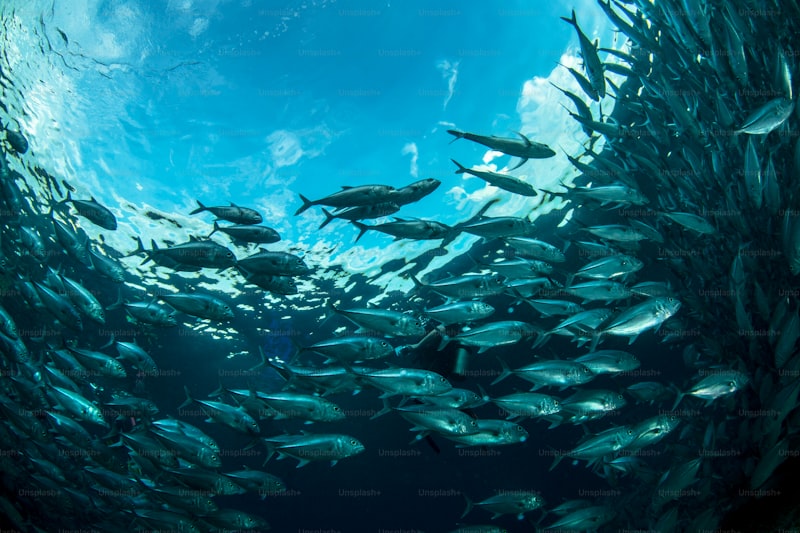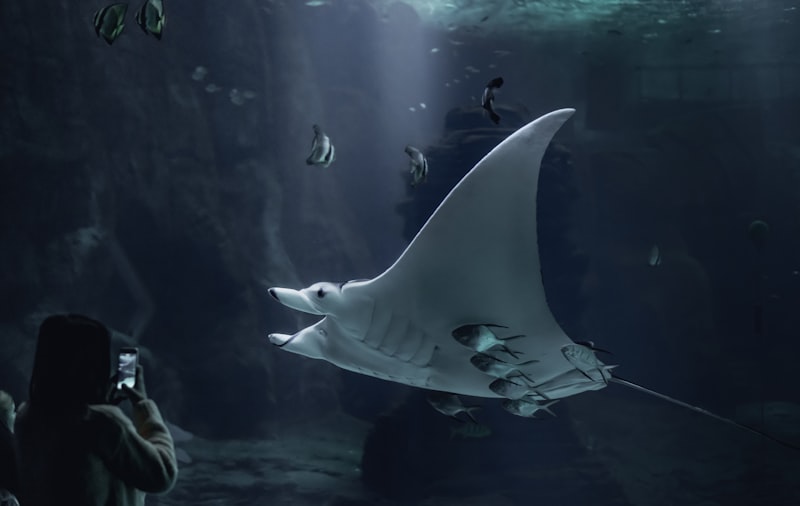One of the most peculiar creatures discovered in the depths is the Anglerfish. Picture this: a creature with a bioluminescent lure dangling above its mouth, designed to attract unsuspecting prey in the darkness. It’s like a deep-sea fishing rod, but living and breathing. This adaptation allows the Anglerfish to thrive in the extreme pressures and darkness of the abyssal zone, where food is scarce and survival is a constant challenge.
Moving on to the Goblin Shark, often referred to as the “vampire shark” due to its frightening appearance. Imagine a pink-skinned shark with a long, flat snout and protruding teeth that resemble fangs. It’s a living relic from prehistoric times, perfectly adapted to ambush its prey with a sudden burst of speed. Despite its eerie appearance, the Goblin Shark plays a crucial role in maintaining the delicate balance of deep-sea ecosystems.
Then there’s the Barreleye Fish, also known as the “spook fish”. Its most distinguishing feature? Transparent head. Yes, you read that right. Its head is transparent, allowing its tubular eyes to rotate inside and scan the waters above for potential meals. This adaptation gives it a unique advantage in spotting prey while remaining hidden from predators lurking in the depths.
Moving to the Deep-Sea Hatchetfish, which looks like it could have been designed by an artist with a love for geometric shapes. Its body is flattened laterally, resembling a hatchet, hence its name. This shape helps it evade predators by making it difficult to spot from below, while its silvery sides blend with the sunlight filtering through the water from above.
Lastly, let’s not forget the Viperfish, with its long, needle-like teeth and bioluminescent photophores running along its body. It’s a predator built for the darkness, using its glowing lure to attract prey closer before striking with incredible speed and precision.
These strange fish species are just a glimpse into the astonishing diversity and adaptations found in the deep waters of our planet. Each one has evolved to thrive in one of Earth’s most extreme environments, reminding us of the boundless wonders yet to be discovered beneath the waves.
Deep Sea Discoveries: Unveiling the Most Bizarre Fish Species
Imagine encountering the Barreleye fish, with its transparent head revealing its barrel-shaped eyes pointing upwards. This adaptation allows it to see prey silhouetted against the faint light filtering from above, a marvel of evolutionary design.
Then, there’s the Fangtooth fish, aptly named for its menacing teeth that, proportionally, are the largest in the animal kingdom. Despite its ferocious appearance, it mostly feeds on smaller fish and crustaceans, surviving in the harsh abyssal environment.

The Anglerfish, famous for its bioluminescent lure dangling in front of its mouth, attracts unsuspecting prey before engulfing them with its cavernous jaws. This adaptation illustrates nature’s ingenuity in exploiting minimal light resources for survival.
Moving deeper into the abyssal plains, one might encounter the Gulper Eel, known for its enormous mouth capable of swallowing prey much larger than itself. Its slender body and expandable stomach allow it to consume meals in one swift motion, a strategy crucial for survival in the food-scarce depths.
The Hatchetfish, with its thin, silver body and laterally flattened shape, resembles a flying object gliding through the water. Its unique physique aids in camouflaging from predators lurking above, reflecting light to blend seamlessly with the environment.
These deep-sea discoveries not only astound scientists but also ignite curiosity about the hidden wonders of our planet. Each species adapts uniquely to survive in an environment where few species can thrive, showcasing the diversity of life even in the most extreme conditions.
As researchers continue to explore the abyssal depths, new discoveries await, promising to unravel more mysteries and shed light on the remarkable adaptations that have evolved in the most bizarre fish species.
Mysteries of the Deep: Exotic Fish Species Unearthed in Uncharted Waters
Imagine encountering the mesmerizing sight of a coelacanth, a prehistoric fish once thought to have gone extinct with the dinosaurs. Its ancient appearance, with lobed fins resembling limbs, evokes a sense of awe at nature’s resilience and adaptation over millions of years.
Or consider the eerie beauty of the anglerfish, with its bioluminescent lure dangling from its forehead like a fishing rod in the abyss. This deep-sea predator epitomizes both the ingenuity and the ruthlessness required to survive in such harsh environments.
Then there’s the gulper eel, aptly named for its enormous, hinged jaw that allows it to swallow prey much larger than itself. Its elongated body and translucent skin are a testament to the strange and otherworldly forms life can take beneath the waves.
These creatures, along with countless others, remind us of the vastness of Earth’s oceans and the endless wonders they contain. Each species has evolved unique adaptations to thrive in the extreme pressures and darkness of the deep sea, where temperatures can plummet and food is scarce.
Exploring these depths requires not just scientific curiosity, but also a deep respect for the unknown. The discoveries made in these uncharted waters continue to challenge our understanding of life on Earth and inspire new questions about the origins and diversity of species.
As we uncover more about these exotic fish species, we are also reminded of our responsibility to preserve and protect the fragile ecosystems they inhabit. The mysteries of the deep offer us a glimpse into a world that remains largely unexplored—a world where every new discovery sparks both wonder and a renewed sense of wonder at the beauty and complexity of our planet’s oceans.
Beyond the Abyss: Weird and Wonderful Fish Species Discovered at Record Depths
Imagine a creature with a lantern-like lure hanging in front of its face, attracting prey like a beckoning beacon in the darkness. This is the anglerfish, a master of camouflage and patience, found in depths so deep that sunlight never penetrates. Its grotesque appearance belies its clever survival tactics, showcasing nature’s ingenuity in the most unlikely places.
Then there’s the gulper eel, aptly named for its enormous mouth that can engulf prey much larger than itself. This deep-sea denizen sports a long, serpent-like body and is known for its distensible stomach, allowing it to gulp down prey whole. It’s a reminder of how creatures in the deep have evolved to utilize every advantage in their harsh environment.
Venture deeper still, and you might encounter the fangtooth, a fish with teeth so large they can’t even close their mouths. Despite its intimidating appearance, this predator is relatively small, yet perfectly adapted to catch elusive prey in the pitch-black waters. It’s a testament to the survival of the fittest, where even the smallest adaptations can mean the difference between life and death.
The barreleye fish takes transparency to a whole new level with its transparent head, revealing its intricate internal structures and eyes that can rotate to look upwards. This evolutionary marvel allows it to navigate the depths with unparalleled precision, always alert to potential threats or opportunities in its unforgiving habitat.
Aliens of the Deep: Meet the Strangest Fish Species Ever Recorded
Have you ever wondered what lurks beneath the ocean’s surface? Dive into the world of deep-sea creatures, where reality often surpasses imagination. Among these extraordinary beings are the “Aliens of the Deep” – a collection of fish species that defy conventional biology and challenge our understanding of marine life.
One of the most bizarre inhabitants of the deep seas is the Barreleye fish (Macropinna microstoma). Imagine a fish with a transparent head, through which its green, tubular eyes can rotate upward to spot prey above. This adaptation allows it to thrive in the darkness of the ocean depths, where sunlight barely penetrates.
Another peculiar resident is the Fangtooth fish (Anoplogaster cornuta), known for its menacing appearance despite its relatively small size. Its oversized teeth, proportionally the largest of any fish, earned it the nickname “ogrefish”. Despite its fearsome look, the Fangtooth fish lives in the abyssal depths, far from human reach.

Then there’s the Blobfish (Psychrolutes marcidus), often described as the “world’s ugliest fish”. Its gelatinous appearance and lack of muscle structure make it appear like a formless mass underwater. Found off the coasts of Australia and New Zealand, this fish demonstrates how unique adaptations help species survive in extreme environments.
These “Aliens of the Deep” remind us of the vast diversity of life in our oceans and the mysteries that still await discovery. From transparent heads to grotesque appearances, each species has evolved distinct features to thrive in their harsh habitats. Exploring these creatures not only expands our scientific knowledge but also sparks wonder about the incredible adaptations nature has developed over millions of years.
Discover more about these extraordinary fish species and delve into the depths of our planet’s last frontier, where every dive reveals new wonders and challenges our perceptions of what it means to be alive.
Deep Ocean Enigma: Scientists Encounter Never-Before-Seen Fish Species
During a routine deep-sea expedition, researchers encountered a species of fish unlike any documented before. Picture this: a creature with translucent skin that glows softly in the darkness, its movements fluid and graceful as it navigates through the cold, pressurized waters. It’s a scene straight out of a science fiction novel, yet it’s real – a testament to the wonders that still await discovery beneath the ocean’s surface.
What makes this discovery truly captivating is not just its novelty, but the questions it raises. How has this species evolved to survive in such extreme conditions? What role does it play in the intricate ecosystem of the deep sea? These questions are more than academic – they hint at the interconnectedness of life forms and the delicate balance that sustains our planet.
As scientists meticulously study this newfound creature, they are unraveling layers of the ocean’s mysteries. Every detail observed, from the shape of its fins to the patterns on its scales, provides clues to its evolutionary journey. It’s akin to solving a puzzle where each piece reveals a deeper insight into the complexity of life below the waves.
This discovery serves as a reminder of how little we know about the ocean’s depths. It’s a vast realm where new species and phenomena continue to surprise us, challenging our understanding of what lies beneath. As we delve deeper into these uncharted waters, one thing is certain – there are still countless marvels awaiting discovery, each more awe-inspiring than the last.
Frequently Asked Questions
Where are the weirdest deep-sea fish habitats located?
Discover where the weirdest deep-sea fish habitats are located with our concise FAQ. Learn about unique ecosystems like the Mariana Trench, the Hadal Zone, and hydrothermal vents, where fascinating and unusual marine life thrives in extreme conditions.
What are the most unique features of deep-sea fish anatomy and behavior?
Discover the unique features of deep-sea fish anatomy and behavior, including bioluminescence for camouflage and communication, enlarged eyes adapted for low-light environments, and pressure-resistant bodies suited to extreme depths.
What are some bizarre fish species discovered in the deep ocean?
Discover fascinating deep-sea fish species that defy imagination with our FAQ on bizarre fish discovered in the deep ocean. Learn about unique adaptations, strange appearances, and the incredible diversity thriving in the ocean’s depths.
Why do deep-sea fish have unusual adaptations compared to shallow-water fish?
Discover why deep-sea fish exhibit unique adaptations unlike shallow-water fish. Their specialized features such as bioluminescence, large eyes, and pressure-resistant bodies are adaptations to survive in extreme deep-sea environments where light is scarce and pressures are immense.
How do fish adapt to extreme pressures in deep-sea environments?
Learn how fish adapt to extreme pressures in deep-sea environments, exploring their unique physiological features like flexible bones and specialized proteins that enable survival under high pressure conditions.


